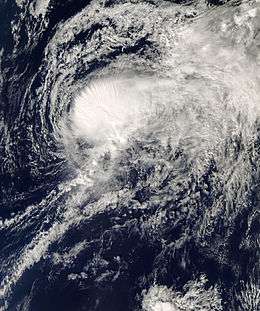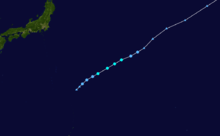Tropical Storm Haishen (2008)
| Tropical storm (JMA scale) | |
|---|---|
| Tropical storm (Saffir–Simpson scale) | |
 Tropical Storm Haishen on November 16 | |
| Formed | November 14, 2008 |
| Dissipated | November 18, 2008 |
| (Extratropical after November 17, 2008) | |
| Highest winds |
10-minute sustained: 75 km/h (45 mph) 1-minute sustained: 75 km/h (45 mph) |
| Lowest pressure | 1004 hPa (mbar); 29.65 inHg |
| Fatalities | None reported |
| Damage | None |
| Areas affected | None |
| Part of the 2008 Pacific typhoon season | |
Tropical Storm Haishen was the twentieth officially recognized tropical storm of the 2008 Pacific typhoon season. The tropical depression that was to become Tropical Storm Haishen formed late on November 14, as a minor tropical depression to the south of the Ogasawara Islands, however the Japan Meteorological Agency (JMA) did not start issuing advisories on it until early the next day. As the JMA were starting to issue advisories on the minor tropical depression, the Joint Typhoon Warning Center (JTWC) reported that it was not expected to become a significant tropical cyclone within 24 hours as they anaylised the depression as subtropical. During that afternoon the JMA upgraded the depression to a full tropical depression while the JTWC issued a Tropical Cyclone Formation Alert on the developing depression as it had become Tropical. That evening, the JMA reported that the depression had become a tropical storm and named it as Haishen while the JTWC designated Haishen as Tropical Depression 25W. Early on November 16, the JTWC upgraded the depression to a tropical storm and then both the JMA and the JTWC declared it had reached its peak intensity with winds of 75 km/h (45 mph). At this time, the JTWC reported that there were signs in satellite imagery that Haishen had started its extratropical transition and then issued their final advisory 12 hours later. The JMA continued to issue advisories on Haishen for another 24 hours, when they declared that Haishen had become an extratropical low. The extratropical low then raced across the Pacific Ocean and crossed the International Dateline later that day. There were no casualties or Impact reported from Haishen as it remained out to sea throughout its life.
Meteorological history

On November 14, the JMA reported that a minor tropical depression had formed 490 km (300 mi) to the southeast of Iwo To,[1] despite the JTWC noting the tropical cyclone formation was unlikely within the next 24 hours[2] due to lack of deep convection.[3] Later that day, the JMA designated the low as a full tropical depression while later that afternoon as deep convection persisted along the eastern portion of a low level circulation center, indicating the storm developed a fully warm tropical core.[4][5] Despite increased vertical wind shear, the JTWC issued a Tropical Cyclone Formation Alert on the system.[5] During that evening the JMA upgraded the depression to a tropical storm and named it Haishen whilst, the JTWC designated Haishen as Tropical Depression 25W while it was located 900 km (560 mi) to the east of Iwo To.[6][7] Early on November 16, Haishen attained its peak intensity of 75 km/h (45 mph).[1][8] Traveling along the north portion of a subtropical ridge to the southeast of the system, dry air began to take toll on the system.[8] The JTWC then issued their final warning later that day as they thought that Haishen was rapidly taking on extratropical characteristics as it had lost most of its deep convection.[9] However, the JMA kept issuing advisories on Haishen for another 24 hours before following suit.[1][2] The extratropical low of Haishen accelerated towards the International Dateline and crossed into the central Pacific later that day.[2][10] As an extratropical low, the system briefly reintensified.[2]
Preparations, impact and naming
As Haishen remained out over open waters for the duration of its existence, there was no impact on any land-masses.[2]
The name Haishen was submitted to the World Meteorological Organisation's Typhoon Committee by the People's Republic of China and was one of the original names submitted for use from January 1, 2000.[11] The name Haishen is Chinese for the God of the sea and was last used in the 2002 Pacific typhoon season.[11][12]
See also
References
- 1 2 3 "Tropical Cyclone Best tracks 2000-2009". Japan Meteorological Agency. 2014-02-06. Retrieved 2014-08-12.
- 1 2 3 4 5 Gary Padgett (08-02-2009). "Monthly Global Tropical Cyclone Summary November 2008". Australian Severe Weather. Retrieved 2009-02-09. Check date values in:
|date=(help) - ↑ "Significant Tropical Weather Advisory for the Western and Southern Pacific Oceans". Joint Typhoon Warning Center. 2008-11-15. Archived from the original on November 15, 2008. Retrieved 2009-02-09.
- ↑ "Tropical Cyclone Advisory 15-11-08 12z". Japan Meteorological Agency. 2008-11-15. Archived from the original on November 15, 2008. Retrieved 2009-02-09.
- 1 2 "Tropical Cyclone Formation Alert". Joint Typhoon Warning Center. 2008-11-15. Archived from the original on November 15, 2008. Retrieved 2009-02-09.
- ↑ "Tropical Cyclone Advisory 15-11-08 18z". Japan Meteorological Agency. 2008-11-15. Retrieved 2009-02-09.
- ↑ "Tropical Cyclone Warning 15-11-08 18z". Joint Typhoon Warning Center. 2008-11-15. Archived from the original on November 15, 2008. Retrieved 2009-02-09.
- 1 2 "Tropical Cyclone Warning 16-11-08 00z". Joint Typhoon Warning Center. 2008-11-16. Archived from the original on November 16, 2008. Retrieved 2009-02-09.
- ↑ "Tropical Cyclone Warning 16-11-08 12z". Joint Typhoon Warning Center. 2008-11-16. Archived from the original on November 16, 2008. Retrieved 2009-02-09.
- ↑ "Summary of the 2008 Typhoon Season". Japan Meteorological Agency. 2008-01-20. Retrieved 2009-02-09.
- 1 2 "Tropical Cyclone Names 2000-2001". Hong Kong Observatory. 2000. Retrieved 2009-02-08.
- ↑ Gary Padgett (03-09-2005). "Monthly Global Tropical Cyclone Summary November 2002". Typhoon 2000. Retrieved 2009-02-08. Check date values in:
|date=(help)
External links
| Wikimedia Commons has media related to Tropical Storm Haishen (2008). |
- JMA General Information of Tropical Storm Haishen (0820) from Digital Typhoon
- JMA Best Track Data of Tropical Storm Haishen (0820) (Japanese)
- JTWC Best Track Data of Tropical Storm 25W (Haishen)
- 25W.HAISHEN from the U.S. Naval Research Laboratory
